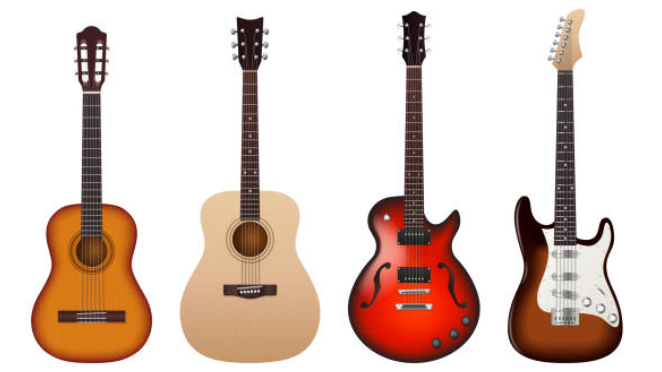How to Tune Your Guitar – 5-Step Easy Guide

Tuning your guitar is one of the most essential skills you’ll need as a guitarist, whether you’re a beginner or an experienced player. It ensures your instrument sounds great and allows you to play with others harmoniously. But if you’re new to guitar, tuning might seem a little daunting. Don’t worry! I’ll guide you step-by-step so that you can get your guitar to sound pitch-perfect.
Why Tuning Your Guitar is Important
Before we dive into the steps, it’s important to understand why tuning matters. When your guitar is out of tune, even the best playing will sound off. Playing with an untuned instrument can throw off your sense of pitch and make learning songs frustrating. A well-tuned guitar ensures that your practice sessions are productive and that your music sounds the way it’s meant to.
Step 1: Familiarize Yourself with Standard Tuning
Guitars are typically tuned to E-A-D-G-B-E, starting from the lowest (thickest) string to the highest (thinnest) string. Here’s a quick breakdown:
- 6th String (E) – Lowest and thickest string
- 5th String (A)
- 4th String (D)
- 3rd String (G)
- 2nd String (B)
- 1st String (E) – Highest and thinnest string
This is called “standard tuning, ” the most common tuning for guitars. Many songs across all genres are written with this tuning in mind.
Step 2: Use a Tuner
There are several types of tuners you can use to tune your guitar:
- Clip-on Tuners: These attach to the headstock and read the vibrations of the strings. They’re great for beginners as they’re portable and easy to use.
- App Tuners: Many free apps can help you tune your guitar using your phone’s microphone.
- Pedal Tuners: These are mostly used by electric guitarists and are connected directly to your guitar.
- Built-in Tuners: Some guitars come with tuners integrated into their design, often in the case of acoustic-electric guitars.
For now, we’ll use either a clip-on tuner or an app-based tuner.
Step 3: Tune Each String
- Starting with the 6th string (low E): Pluck the string gently.
- Watch the tuner: It will tell you how close you are to the correct note (E in this case). If the note is too low, also called flat, tighten the tuning peg. If the note is too high, or sharp, loosen the tuning peg.
- Adjust slowly: You want to bring the string into pitch gradually. Tune up to the note (meaning you should always tighten the string to reach the correct pitch rather than loosening it).
- Move on to the next string: Repeat the process for the A, D, G, B, and high E strings. Always pluck the string lightly, as pressing too hard can give the tuner a false reading.
Step 4: Recheck Your Strings
After you’ve gone through and tuned each string, it’s a good idea to go back and double-check them. Sometimes tuning one string affects the others, especially on newer guitars. A quick pass through the strings again ensures everything is perfectly in tune.
Step 5: Practice Ear Training
While tuners are incredibly useful, developing the ability to tune your guitar by ear is a valuable skill. One way to practice is by using the **5th fret method**:
- Play the 5th fret of the 6th string (E): It should sound like the open “5th string (A)”. Adjust the 5th string until the two notes match.
- Play the 5th fret of the 5th string (A): It should sound like the open “4th string (D)”.
- Play the 5th fret of the 4th string (D): It should sound like the open “3rd string (G)”.
- Play the 4th fret of the 3rd string (G): It should sound like the open “2nd string (B)”.
- Play the 5th fret of the 2nd string (B): It should sound like the open “1st string (E)”.
This technique trains your ear to hear when two notes are in harmony.
Tips for Keeping Your Guitar in Tune
- Change your strings regularly: Old strings are harder to keep in tune. They lose their elasticity and start to sound dull.
- Stretch new strings: If you’ve just put on new strings, they will need some time to settle. Tune them and then give them a gentle pull to help them stretch.
- Store your guitar properly: Temperature and humidity changes can cause your guitar to go out of tune. Store it in a place where the environment is stable.
- Use a quality tuner: Whether it’s a clip-on tuner or a pedal, invest in a good one that you trust.
Final Thoughts
Tuning your guitar is a basic but essential part of playing. With practice, it becomes second nature, and your ear will naturally learn to recognize when something is off. Whether you’re using a tuner or your own ears, ensuring that your instrument is in tune will make everything you play sound better. Keep practicing, and soon tuning will be a quick, easy part of your guitar routine.
Now, go grab your guitar, and get it sounding great!
If you’re interested in learning an instrument, at Real Brave, we offer an incredible experience like no other place in music lessons for kids and adults by guiding them from the beginning stages of getting to know an instrument all the way through performing for family and friends on stage. Our instructors come from all over the world, bringing extensive experience on a wide range of instruments. Click below and book a free lesson with us!
Author: Daniel Powers Jr, the founder of Real Brave™, serves as the chief inspiration to thousands of students in the Real Brave music instruction program. He’s also the visionary behind PracticePad™, an online platform for live one-on-one online music lessons, lesson tracking, and scheduling. Beyond his entrepreneurial pursuits, Daniel leads a non-profit organization that provides formerly homeless children with access to music education, making a profound impact on their lives. His unwavering dedication to music, innovation, and education continues to inspire individuals to reach their fullest potential while creating positive change in communities. Follow Real Brave on all the socials:
youtube.com/@realbraveinc
twitter.com/realbraveinc
https://www.tiktok.com/@realbraveinc
instagram.com/realbraveaudio
facebook.com/realbraveinc






